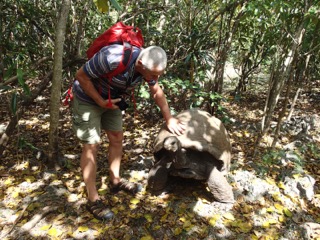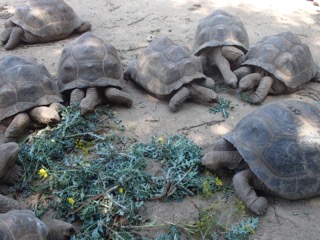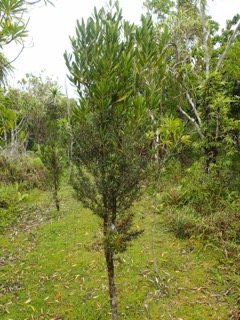Giant tortoises

VulcanSpirit
Richard & Alison Brunstrom
Tue 27 Oct 2015 20:30
| The Indian Ocean giant tortoises are fascinating, if you like that sort of thing. Modern genetics shows convincingly that they all originated from Madagascar, from a parent species now extinct (probably as a result of human arrival on the island long before the European period). From there the animals colonised many of the Seychelles islands developing into several different species. They also reached the Mascarenes; first Mauritius, then Rodrigues from Mauritius, and lastly Reunion from Mauritius. Two species evolved on Mauritius, a further two on Rodrigues, and a fifth species on Reunion. All of this has happened fairly recently in geological terms - Reunion is only about three million years old. Tortoises float, and can survive for months with neither food nor water so it is fairly easy to see how they could reach these remote islands. The parallels with Galapagos are very clear - even to the extent of two of the bigger species, on Mauritius and Rodrigues, becoming saddlebacks (with a large saddle-shaped notch in the upper shell enabling them to crane their necks up to reach higher vegetation), a huge competitive advantage. None of these tortoises survived the arrival of man. Within a hundred years of the Dutch arrival on the islands in the early seventeenth century they had almost all gone. Those on Reunion probably lasted longest, until the early nineteenth century, but they are also the least well documented. Hundreds and hundreds of thousands of animals slaughtered ending almost in the blink of an eye millions of years of evolution. The fate of the Seychelles tortoises attracted the attention of Charles Darwin himself, in his only known venture into conservation - a concept barely even conceived at that time. He and other eminent scientists realised that almost all the Seychelles tortoises had already gone and that the last remain species, on Aldabra, was at risk of following them. They persuaded the British government to relocate a few tortoises from Aldabara to Mauritius to preserve the species. This was done, and their descendants are thriving - albeit not in the wild.   This is a full grown young male (about 90 yrs) happily plodding around the Ile aux aigrettes nature reserve in southern Mauritius where their grazing habits are helping to recreate the native dry forest. Tortoises love to have their necks rubbed; they stretch out their heads and rise up on all four legs with their heavy body well clear of the ground, obviously in ecstasy. This guy has just been stroked, and is asking for more. They also like to have their shells stroked. Surprisingly the shells are very sensitive, especially around the plate joins, and a nice gentle rubbing probably seems much like a massage to them. This is the tortoise breeding reserve on Rodrigues. It’s a great success and there are now a few thousand tortoises here. The eventual intention is to release them back into the wild on the island when sufficient habitat has been recreated. These youngsters are tame, and will run over (figuratively speaking) to have their necks scratched    Tortoises are aggressive grazers, and play an important role in maintaining the native forests by munching their way through the undergrowth, helping the spread of seeds like those of the ebony and ensuring an open understory which enables better seedling germination. But as ever in nature, it’s an arms race. Some plants have evolved ways to discourage tortoise browsers. Here for example is a heterophyllous tree - one with more than one type of leaf:  The young tree has narrow pointed unpleasant-tasting leaves, low in nutrients, while they are in reach of tortoises, but as soon as they get above tortoise neck length the leaves change form completely becoming much broader and therefore more efficient at generating food for the plant via photosynthesis, and less bitter to tortoises - but that doesn’t matter because they’re out of reach! Fascinatingly, exactly the same mechanism was developed by several trees in New Zealand to guard against grazing by moas. Sadly this defence is no longer needed there, but it may be again in Mauritius. |